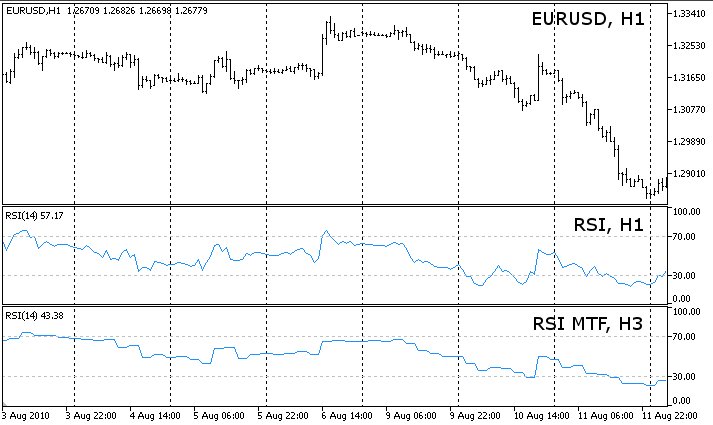당사 팬 페이지에 가입하십시오
- 조회수:
- 156
- 평가:
- 게시됨:
-
이 코드를 기반으로 한 로봇이나 지표가 필요하신가요? 프리랜스로 주문하세요 프리랜스로 이동
이 RSI(상대강도지수) 지표는 현재 차트의 차트 주기보다 높거나 낮은 모든 주기에 적용할 수 있습니다.
참고: 자신만의 다중 차트주기 지표를 만들고 싶다면 이 RSI MTF 인디케이터가 좋은 예입니다. 버퍼가 하나뿐이므로 버퍼가 많은 다른 다중 차트주기 인디케이터보다 코드가 덜 복잡하고 이해하기 쉽습니다.
내장된 iRSI 인디케이터의 모든 일반적인 매개변수를 사용할 수 있으며, 추가 설정은 계산에 입력으로 사용되는 두 번째 차트주기가 유일합니다.
인디케이터가 현재 차트의 차트 주기보다 낮은 주기에 적용되면 모든 값을 표시할 수 없습니다. 이 경우 선택한 가격 유형에 따라 가장 적절한 값을 제공하기 위해 다른 접근 방식을 사용합니다.
두 가지 예를 들어보겠습니다:
- timeframe_1=5분, timeframe_2=1분, 종가 계열을 기준으로 계산:
timeframe_1의 모든 막대에 대해 표시기는 timeframe_1의 막대 종가 시간 이전 또는 시간에 종가 시간이 있는 timeframe_2의 최신 막대를 표시합니다. 이는 아직 열려 있는 현재 막대뿐만 아니라 닫힌 막대에도 적용됩니다.
- timeframe_1=5분, timeframe_2=1분, 시초가 계열을 기준으로 계산합니다:
timeframe_1의 모든 막대에 대해 표시기는 timeframe_1의 막대 개장 시간 이전 또는 개장 시간에 timeframe_2의 최신 막대를 표시합니다. 이는 아직 열려 있는 현재 막대뿐만 아니라 닫힌 막대에도 적용됩니다. 여기서 논리는 바의 오픈 시간에 지표를 계산하도록 선택하면 새 바가 열릴 때도 거래할 수 있다는 것입니다. 이 경우 새로운 5분 막대가 열리면 그 일부인 5개의 1분 막대 중 첫 번째 막대의 오픈만 알 수 있습니다. 따라서 두 번째부터 다섯 번째 1분 막대의 시가는 계산에서 무시됩니다.
시간 프레임이 동기화되지 않더라도 다른 시간 프레임과 혼합할 수 있습니다(예: timeframe_1 = 5분, timeframe_2 = 12분). 표시기는 동기화 상태를 유지합니다. 작동 방식은 위의 예와 유사합니다.
엑셀 시트에서 보다 시각적인 설명을 보려면 MACD 히스토그램 MTF MC 인디케이터를 참조하세요.
차트주기를 전환할 때는 가격 데이터가 로드될 때까지 약간의 시간(몇 초)을 기다리세요. 인디케이터가 표시되지 않으면 차트를 수동으로 새로고침하세요.
소스를 살펴보고 오류 메시지를 켜거나 끕니다:
bool ShowErrorMessages=false; // 디버깅을 위한 오류 메시지 켜기/끄기

업데이트 내역:
2010 09 26: v04
- 차트의 차트 주기보다 작은 주기의 값 표시가 개선되었습니다;
- 버퍼를 0이 아닌 EMPTY_VALUE로 설정: if(convertedTime<tempTimeArray_TF2[0]);
- 코드 최적화;
- 단일 시간 프레임 표시기에서 상속된 OnInit()에서 PLOT_DRAW_BEGIN을 제거했습니다;
- 버퍼와 배열의 ArraySetAsSeries를 OnInit()으로 옮겼습니다;
2010 09 06: v02
- 인디케이터가 잘못 그려지던 Time[] 배열의 버그를 수정했습니다;
2010 08 25: v01
- 인디케이터가 처음 게시되었습니다;
MetaQuotes Ltd에서 영어로 번역함.
원본 코드: https://www.mql5.com/en/code/178
 Functions to simplify work with orders
Functions to simplify work with orders
우리가 원하는 것은 주문하는 방법의 구문과 값이 아니라 알고리즘과 메서드에 대해 생각하는 것입니다. 여기에는 MQL5에서 포지션을 관리하는 간단한 함수가 있습니다.
 Download all ticks of a symbol's history
Download all ticks of a symbol's history
마켓 워치의 모든 심볼에 대해 브로커에서 모든 틱을 다운로드합니다. 모든 기록 또는 가능한 경우 과거의 특정 날짜까지 다운로드합니다.
![Stochastic multi-timeframe [v04]](https://c.mql5.com/i/code/indicator.png) Stochastic multi-timeframe [v04]
Stochastic multi-timeframe [v04]
스토캐스틱 인디케이터는 모든 차트 주기에 적용할 수 있습니다(현재 차트의 차트 주기보다 높거나 낮음).
 Useful #define statements
Useful #define statements
다음은 EA에서 작업을 수행하는 데 유용한 몇 가지 #define 문입니다. 파일 시작 부분에 변수 이름만 지정한 다음 다른 #define 문이 작업을 수행하도록 하면 됩니다. 이 파일을 사용하려면 EA 파일의 첫 줄에 #include <DEFINE_statements.mqh> 를 추가하세요.